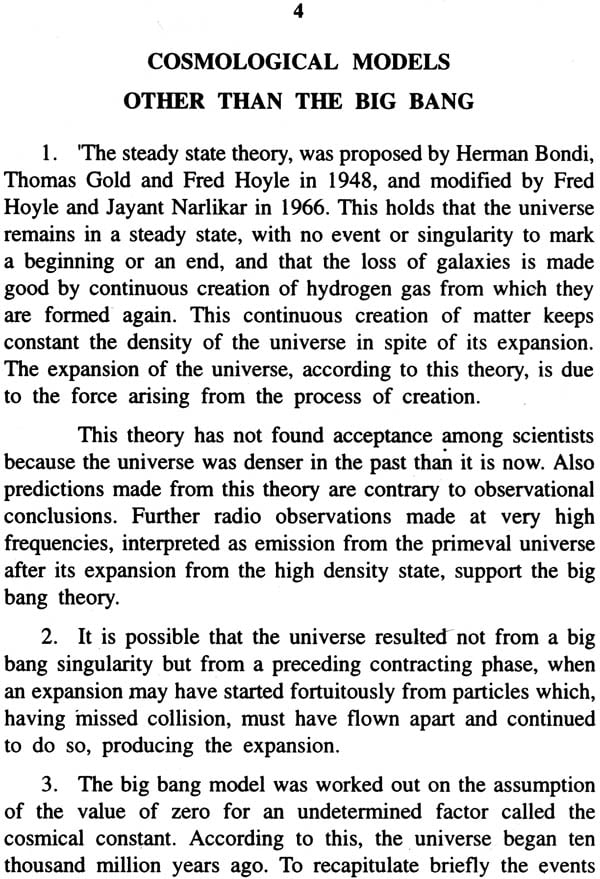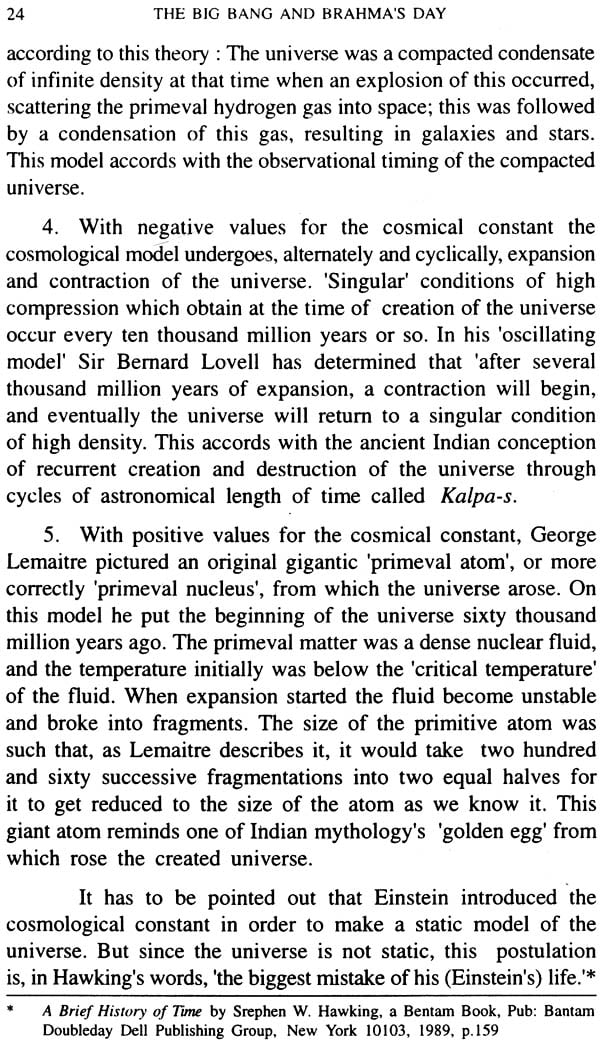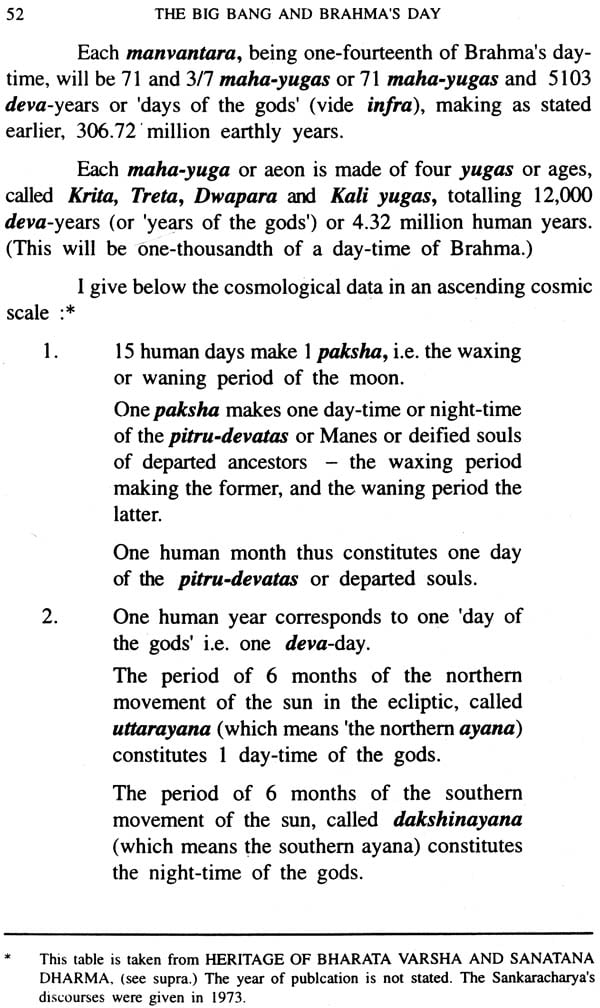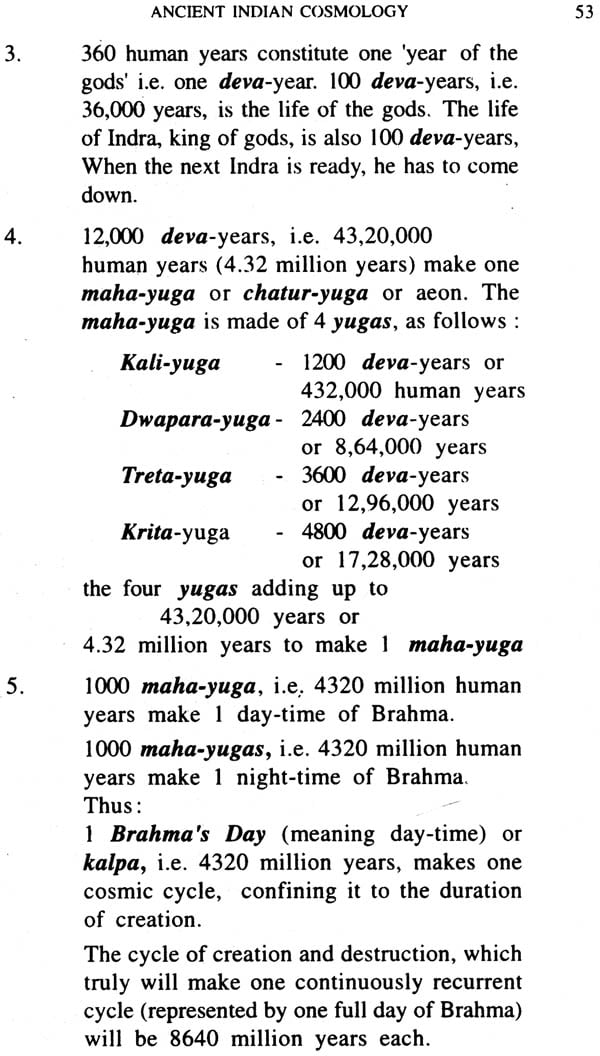
The Big Bang and Brahma's Day (A Rare Book)
Book Specification
| Item Code: | NAF461 |
| Author: | Purasu Balakrishanan |
| Publisher: | Bharatiya Vidya Bhavan |
| Language: | English |
| Edition: | 1995 |
| ISBN: | 8172760574 |
| Pages: | 73 |
| Cover: | Paperback |
| Other Details | 8.5 inch x 5.5 inch |
| Weight | 100 gm |
Book Description
Written by a distinguished man of science as well as letters, The Big Bang and Brahma’s Day is a highly informed, many-sided exploration of its fascinating cosmic theme. Part I, entitled The Big Bang, is a popular presentation of modern astrophysics. Part II, entitled Interlude, throws side-lights from religion and literature on the theme, making the scope of the book larger than science. Part III presenting ancient Vedic and upanishadic idea, relates these to the modern scientific account. The study reveals the daring spirit of inquiry exhibited by the ancient seers, like that of the modern scientists, and brings out the remarkable fact that the cosmological time-scales evolved by them is of a magnitude comparable to that of modern astrophysics.
Swami Ranganathananda, in his learned foreword, points out that, given the similarity of perception, ancient Indian astronomy gives due place to the manifestation of intelligence-Brahman-in Creation, which western astronomy astronomy does not, notwithstanding a random voice or two.
Dr. S. Balakrishan was professor of Pediatrics at Jawaharlal Institute of Post-graduate Medical Education and Research, Pondicherry. He is known to the literary world, Tamil and English, for over fifty-five years, as Purasu Balakrishnan – short-story writer, essayist, biographer, novelist, dramatist and poet. His works have been the subject of theses for the M.Phil. and Ph.D. degrees. Some have been translated into Kannada, Hindi, Telugu and English.
Dr. Purasu Balakrishnan has written this book on comparative astronomy under the title The Big Bang and Brahama’s Day. I have been requested by him and Sri S. Ramakrishnan of the Bharatiya Vidya Bhavan, the publishers, to write a foreword to this book.
Modern Western astronomy is closest to ancient Indian astronomy among the astronomies of the rest of the world. The author has shown this closeness between the two. The only difference between the two is that Intelligence finds a prominent place in Indian astronomy, whereas Western astronomy explains the cosmos entirely in physical terms. But Western astronomy is slowly nearing to the Indian point of view by finding a place for Intelligence in cosmology. The British astronomer Fred Hoyle, whom the author quotes as the author of the now rejected Steady State Theory, was a thorough materialist when he advocated the Steady State Theory over forty years ago. But he has now come to recognize that without Intelligence we or cannot explain astronomy cosmology. And he therefore titles his recent book as The Intelligent Universe. Here is a passage from the same which reads thus (p.236):
‘So, starting from astronomy and biology with a little physics we have arrived at religion. What happens if the situation is reversed and we look at science from the religious point of view? How do the two approaches match up? The answer to this question turns on the form of theology. In contemporary western teachings, the points of contact are few, essentially because “God” is placed outside the Universe and in control of it. By contrast, in many other religions, past and present, deities lie very much within the Universe. This is the case with God Brahma in modern Hinduism, for example, and it was also true of the gods of the Nordic peoples and Greeks many centuries ago.
And another passage, (p.244): “A proper understanding of evolution requires that the environment, or the variations on which it operates, or both, be intelligently controlled.”
Here Fred Hoyle has made a good suggestion, but his reference to God Brahma in modern Hinduism is not quite correct because of his ignorance. Indian astronomy speaks of Brahman in neuter gender, and Brahma as the Cosmic Mind in masculine gender. Brahma is described as the origin of the Universe, and the Universe is absorbed back into Him at the end of cycles. The many have come from the One and go back to the One. What is the nature of that One? Vedanta calls it Brahman. The Taittirya Upanishad, in chapter 2, gives the answer Satyam, Jnanam, Anantan ----- Brahman is Truth, Consciousness, and Infinity. When Western astronomy will find a place for Intelligence in its cosmology, it will come to the central idea of Indian astronomy. Western astronomy is preferable, on the other hand, on the details of cosmic evolution. Even in the Visnu Sahasranama of the Mahabharata, the sixth verse giving the fifty-second name of visnu is tvasta ; Sankaracharya in his commentary explains the term tvasta as one who makes the whole world shrunken (tanukarana) at the time of cosmic dissolution. The definition of Brahman in The Taittiriya Upanisad is a precise scientific definition.
The present book will enlighten scientists and laymen alike about the coming closer of modern Western astronomy to the fundamentals of ancient Indian astronomy.
Back from endless vistas of space and time – or should I say, ‘space-time’ – into the privacy of the preface, tete-a-tete with the reader, I wonder, ‘what am I to say for my book?’ This question is actually what R.L. Stevenson put to himself in his preface to his book, An Inland Voyage. The answer which he gave himself may, unexpectedly in view of the different composition of my book, serve me also. Finding no positive answer for himself, he says, ‘in wonder, would a negative be found enticing? For, from the negative point of view, I flatter myself this volume has a certain stamp. Although it runs to considerably upwards of two hundred pages, it contains not a single reference to the imbecility of God’s universe, nor so much as a single hint that I could have made a better one myself – I really do not know where my head can have been.
Notwithstanding the ready cue from Stevenson, I find myself giving thought to the fact that through my years, through the thick and thin of my professional life, I have pursued the gleam of creative literary writing. Now the path seems to be obscured by fog and vapours ; and ironically, when my profession has dropped from me, I have turned for the nonce to a mutatic variant of my writing.
Several years ago I wrote two articles, one entitled, Cosmogony, Theology and the New Physics which appeared in Indian Horizons (of the Indian Council for Cultural Relations) Vol. XXXV November 1-2, 1986, and the other entitled The Cosmic Dance which appeared in two parts in two successive weekly issues (the Science Express) of Indian Express, dated December 26, 1987, and January 5, 1988. A poem of mine entitled The Dance of Siva appeared in slightly different versions in Indian Express of January 2, 1988, and New Quest-73 of January-February, 1989. The present book is an outcome of these.
A personal preface may well end with a personal note of thanks rendered sincerely to Padamsry S. Ramakrishanan of Bharatiya Vidya Bhavan for the Interest that he has taken in this book. May I also express my thanks to Poojyastri Swami Ranganathanandaji for illuminating foreword?
| Foreword | VII | |
| Preface | IX | |
| Prologue | 1 | |
| Part I: The Big Bang | ||
| 1 | A Brief History of Cosmology | 7 |
| 2 | Probing the Cosmos | 11 |
| 3 | The Origin of the Universe : The Big Bang | 17 |
| 4 | Cosmological Models Other Than the Big Bang | 23 |
| 5 | The Building Bricks of Matter | 27 |
| Part II: Interlude | ||
| Indtroductory | 31 | |
| 1 | The Biblical Account of Creation | 32 |
| 2 | A Poet's Recreation of the Genesis | 36 |
| 3 | The Vedic Hymn of Creation | 39 |
| 4 | Brahma's Day | 41 |
| 5 | The Dance of Siva | 43 |
| 6 | The Recreation of the Dance of Sive | 46 |
| Part II: The Big Bang and Brahma's Day | ||
| 1 | A Note on Ancient Indian Astronomy | 49 |
| 2 | A Note on Ancient Indian Cosmology | 51 |
| 3 | The Big Bang and Brahma's Day | 56 |
| References | 61 |









